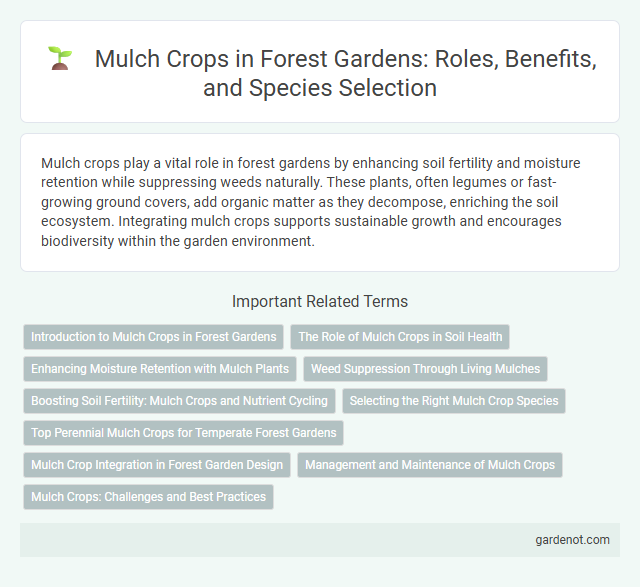Mulch crops play a vital role in forest gardens by enhancing soil fertility and moisture retention while suppressing weeds naturally. These plants, often legumes or fast-growing ground covers, add organic matter as they decompose, enriching the soil ecosystem. Integrating mulch crops supports sustainable growth and encourages biodiversity within the garden environment.
Introduction to Mulch Crops in Forest Gardens
Mulch crops in forest gardens improve soil health by suppressing weeds, retaining moisture, and adding organic matter through decomposition. Common mulch crops include clover, vetch, and comfrey, which fix nitrogen and enhance nutrient cycling. Integrating these plants supports plant diversity and promotes sustainable ecosystem functions in forest garden systems.
The Role of Mulch Crops in Soil Health
Mulch crops play a crucial role in enhancing soil health by improving organic matter content and promoting microbial activity in forest gardens. Their root systems help prevent soil erosion and increase water retention, fostering a stable microenvironment for diverse plant species. Decomposing mulch crops contribute essential nutrients, thereby supporting sustainable nutrient cycling and long-term soil fertility.
Enhancing Moisture Retention with Mulch Plants
Mulch crops such as clover, vetch, and winter rye improve moisture retention by creating a protective layer that reduces soil evaporation and maintains consistent soil hydration. Deep-rooted mulch plants enhance water infiltration and prevent surface runoff, promoting healthier root development in forest gardens. Incorporating mulch crops also enriches soil organic matter, supporting microbial activity essential for sustained moisture availability.
Weed Suppression Through Living Mulches
Mulch crops serve as living mulches in forest gardens, effectively suppressing weeds by shading the soil and outcompeting unwanted plants for nutrients and moisture. Species like clover, vetch, and buckwheat are commonly used due to their rapid ground cover and nitrogen-fixing abilities, enhancing soil fertility while minimizing weed growth. This natural weed management reduces the need for chemical herbicides and helps maintain a healthy, biodiverse ecosystem within the forest garden.
Boosting Soil Fertility: Mulch Crops and Nutrient Cycling
Mulch crops play a vital role in boosting soil fertility by enhancing nutrient cycling within forest gardens. These crops decompose to release essential nutrients like nitrogen, phosphorus, and potassium, promoting healthier plant growth and increased microbial activity. Incorporating mulch crops such as clover, vetch, or rye improves soil structure and organic matter content, leading to sustainable nutrient availability.
Selecting the Right Mulch Crop Species
Selecting the right mulch crop species for a forest garden is essential to enhance soil fertility, suppress weeds, and retain moisture effectively. Leguminous plants like clover or vetch are highly recommended for their nitrogen-fixing properties, which improve soil nutrient content naturally. Deep-rooted species such as comfrey or chicory can break up compacted soil layers and provide biomass for mulch, supporting overall ecosystem health.
Top Perennial Mulch Crops for Temperate Forest Gardens
Top perennial mulch crops for temperate forest gardens include comfrey (Symphytum officinale), white clover (Trifolium repens), and yarrow (Achillea millefolium), which provide dense ground cover and improve soil fertility. These species excel at suppressing weeds, retaining moisture, and enhancing nutrient cycling through deep root systems and rapid biomass production. Effective use of these mulch crops promotes sustainable soil health and supports diverse plant growth in temperate forest garden ecosystems.
Mulch Crop Integration in Forest Garden Design
Mulch crop integration in forest garden design enhances soil fertility by providing organic matter that decomposes gradually, supporting nutrient cycling and moisture retention. Selecting nitrogen-fixing plants such as clover, comfrey, or vetch promotes a sustainable ecosystem by naturally enriching the soil, reducing the need for synthetic fertilizers. Strategic placement of mulch crops beneath fruit trees and shrubs minimizes weed growth and protects root zones, optimizing plant health and overall garden productivity.
Management and Maintenance of Mulch Crops
Effective management and maintenance of mulch crops in forest gardens involve regular monitoring to ensure adequate ground cover and soil moisture retention. Periodic trimming or mowing of mulch plants like legumes prevents overgrowth, promotes nutrient cycling, and supports soil health by adding organic matter. Maintaining a diverse mulch crop species mix enhances pest resistance and improves soil structure through varied root systems.
Mulch Crops: Challenges and Best Practices
Mulch crops in forest gardens improve soil moisture retention and suppress weeds, but they face challenges such as competition for nutrients and potential pest attraction. Selecting species with deep root systems and fast decomposition rates enhances nutrient cycling and minimizes resource competition. Implementing rotational mulching and monitoring crop health are best practices to maintain soil fertility and ecosystem balance.
Mulch crop Infographic

 gardenot.com
gardenot.com